Football Fundamentals: Cover 2 Defense
Cover 2 is often one of the first zone defenses taught in
football. This is because it requires minimal movement, allowing defenders to
focus on the “zone” aspect of the coverage. Just as important, because of the
minimal movement and design of the coverage, it lends naturally to being a
great run defense as all eyes are often focused on the backfield. Once seen as
the go-to defense in football, it has fallen out of favor in the past few
decades with the development of more advanced and complicated vertical passing
attacks. However, recently it has seen somewhat of a resurgence with the “trap”
concept, and it remains a favorite near the goal line.
For completeness, man under will be treated in a different
article.
The Basics (Zone)
| Strengths | Weakness | How to Attack |
|---|---|---|
| Strong run defense (eyes in backfield) | Safeties must cover ground | Four verts |
| Underneath Coverage (5 of 6 zones covered) | Fast vertical routes into hole/corner | Flood concepts |
| Easily adapts to 4 or 5 man rush | Wide splits create lanes | Sideline Levels (ex smash) |
| Quick routes covered | Inside numbers vs run (vs Tampa 2) | "Hole" area between safeties |
| Route disruption | Corner Routes | |
| Strong vs TE |
Cover 2
We’re going to start where it all started, with the basic
cover 2 shell. The Cover 2 named because of the two deep defenders playing “halves”,
splitting the field into two. The safeties will generally align at about 10-14
yards depth just outside the EMOL, though some teams will like to line up with
the strong safety safety tighter to the LOS, getting as close as 7 yards, in
order to help support the run and help the LB in coverage on the TE. Ultimately,
both deep players will end up playing at a depth of about 15-25 yards,
depending on the game situation and other factors.
Then there are five underneath defenders. In this case, the
CB is assigned to cover the flat/out, typically starting with an outside shade
on the outer most receiver so that he can see through the receiver and into the
backfield. The CB can either play a “hang” technique (typically 3-5 yards off
and outside shoulder to two yards outside) or an outside “press”/”jam”
technique, forcing an inside release to inside help (both on short routes and
deep routes there is inside help). If all routes go vertical, you will see the
CBs continue to sink to help protect the safeties.
The OLBs will play the hook/curl zones, depending on where
the most immediate threat is. Preferably, the OLB will never let someone
through his zone without rerouting him and throwing off the timing of the play.
The MIKE will play the hook/hole zone, depending on the call
and the depth he is able to get. In a basic Cover 2, the MIKE is going to generally
be closer to the LOS, and therefore will be more likely to defend the hook
zones. He generally will open up to strength looking for crossers coming into
his zone from that side.
Tampa 2
Tampa 2 is very similar to your basic cover 2, with the
obvious difference being the depth of the MIKE. The MIKE is going to sink –
which often means turn and run – to gain depth in the middle of the field to
cover what is known as the “hole”, which is the void between the halves
safeties and the underneath zone. Of course, the MIKE typically isn’t as good
in coverage as a safety, so the safeties still must cover “halves” and not
thirds, like in a Cover 3, but they can cheat a bit further outside, which
provides more over the top help for the CBs. On the downside, the two OLBs now
need to cover a bit more area underneath, very similar to the underneath coverage
in a Cover 3. The rules remain generally the same for the CB, who still
generally align outside the receiver, looking to force an inside release toward
help.
Trap
Trap (2-Trap) has been around for a while, but it’s really
starting to come into vogue relatively recently. In trap coverage, the CB is
going to read the #2 receiver to the #1 receiver. In this way, it acts as a “pattern
matching” version of Cover 2, and a bit of a hybrid between Cover 2 and Cover
4.
Here, the CBs are generally (though not always) going to
align off the WR, because they need to be able to diagnose the route of the #2.
They are going to use a technique called “soft squat” where they’ll sink, clue
inside on the #2, and squat on any outside route. Or in simple terms, the CB’s
job is to read the #2, and if the #2 runs an outward breaking route, the CB is going
to jump the route. Or to wrap it all in a nice bow, the #2 is going to run
right into the trap set by the CB. If this happens, the safety needs to get
over the top fast, because he has coverage responsibility on the #1.
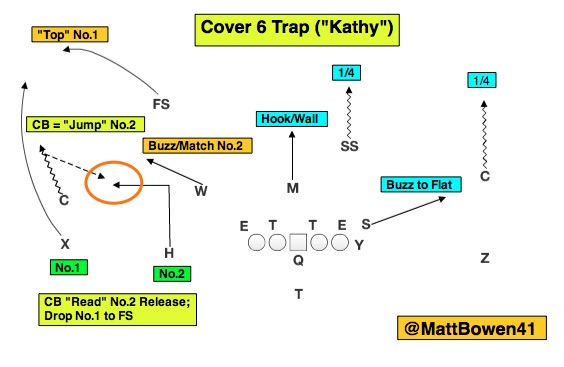 |
| Matt Bowen - Note this is Cover 6, more about this later |
Now, if the #2 goes vertical, the CB is going to continue to
sink before breaking on any underneath throw, while the Safety continues to
play his standard Cover 2 rules.
/cdn0.vox-cdn.com/uploads/chorus_asset/file/4137708/normanpicksix.0.gif) |
| Cat Scratcher Reader |
 |
| Matt Bowen - Note the CB dropping into 1/2, more about later |
Robber
Robber is going to see a safety responsible for the
hook/curl zone as he tries to mess with the QB’s read. Because the safety is
coming down to the LOS, the outside CB is going to be responsible for the deep
half. Because of the CB’s outside alignment and deep drop, along with the
safety moving forward at the snap, this can often look initially like Cover 3
to a QB, and the QB may be tempted to attack underneath. However, the defense
maintains 5 underneath defenders, and that likely isn’t a winning proposition
for the QB. Overall, it’s a nice way to tease a single high coverage pre-snap
and even immediately post snap, while maintaining the benefits of a two-high
look.
This coverage also has the added benefit of adding a safety
to the run defense while dropping a CB back, and often times shifting a nickel
further towards the edge.
Invert (CB Deep 1/2,
Safety Buzz)
In this case, we are simply inverting the coverage responsibilities
of the safety and CB without showing that pre-snap (see Flip for switching the
responsibilities by alignment). Similar to “Robber” this will tease a single
high safety look, as often times the safety will begin to drop down pre-snap
while the CB starts retreating. But by inverting the coverage, you’ve moved a
safety closer to the LOS and run responsibilities and potentially gotten more
speed on the backend. This is a nice way to disguise what you want to do
against a twins or trips set and can allow the defense to better react to the
WR screen game (a safety is buzzing down on the snap while the CB maintains his
pre-snap outside leverage, making it easier to defend outside gaps quicker
against the quick WR screen).
Note that most will check out of this call if there are two vertical threats to one side. If you choose not to, make sure your OLBs are prepared to carry any vertical route from the #2 if both #1 and #2 work vertical.
Invert doesn't have to be limited to a single side either. Many teams will run "Cover 2 Invert" on both sides, particularly against heavier personnel (12, 21, 22 personnel) to get the safeties involved in the run and allow the CBs to do what they do best: cover.
Or you can do a Tampa 2 invert where the safety is the hole defender.
This similarly works well from a nickel package, where the nickel can drop to deep half and the outside CB can stay locked on the WR.
Invert doesn't have to be limited to a single side either. Many teams will run "Cover 2 Invert" on both sides, particularly against heavier personnel (12, 21, 22 personnel) to get the safeties involved in the run and allow the CBs to do what they do best: cover.
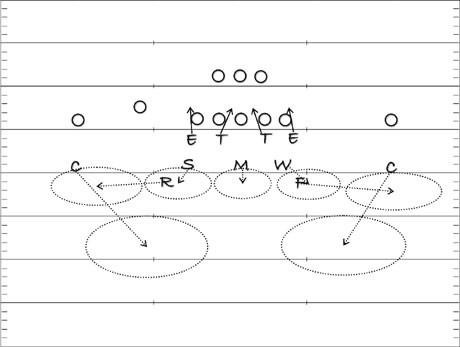 |
| Gridiron Strategies |
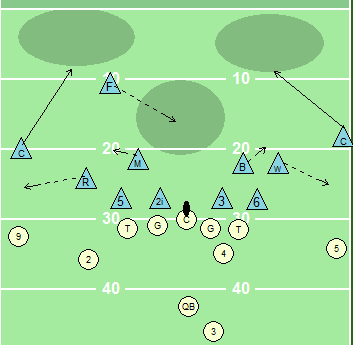 |
| Shakin the Southland |
Flip (Knob Formation,
Safety Down)
“Flip” is simply going to put a safety where the CB
typically is and a CB where the safety typically is. Often times, CBs don’t
like to get mixed up in the run game. Against a knob formation, where there is
no split end or flanker, that often makes the flat defender an essential force
defender against the run. In order to get a guy better suited for that skill,
teams will simply flip the CB and safety pre-snap and allow the safety to play
the flat and the CB to play the deep half.
Green 2
Green 2 is generally reserved for obvious pass situations.
It allows the defense to “put a tent” on top of the defense while having the
CBs sink and protect the safeties more. Generally the safeties will align a bit
deeper presnap, as will the MIKE so that he can better cover the hole. The CBs
may press or jam the initial release to disrupt the timing of the route,
however, after that they will go into more of a trail coverage underneath the
receiver (if the receiver releases inside, the CB will just continue to sink
into his zone). Rather than the CB’s zone being the flat, it will be more of an
out, or right at the sticks. This gives up the flat, but allows the defense to
take away over the top routes and rally around any pass short of the first
down.
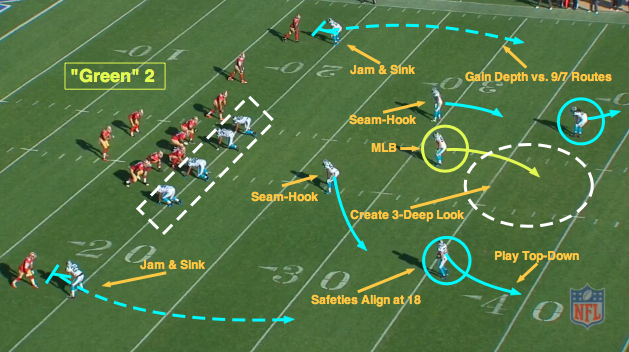 |
| Bleacher Report |
Red 2
Red 2 is a redzone variant of Cover 2. Because there is less
of a threat of being beaten over the top, the safeties can play more flat
footed and play a shuffle technique rather than sinking immediately at the
snap. This allows them to be more involved in the run game and helps take away
quick inward routes like slants and digs.
The CBs will generally play a soft squat technique so that
they can carry and defend the fade route, much like they would in Cover 4.
The LBs must be able to play their zones quicker than usual,
as many play designs in this area will be quicker. This means that the OLBs may
need to widen so they can better defend the hook and seam throws. It also means
the MIKE needs to react immediately to any threat moving inside the hook/seam
defender and carry that receiver all the way through his route to avoid getting
caught hitting a seam against a safety that is looking slant, for instance.
Blitz Shell
A lot of teams like to bring pressure but have concerns
about having to overhaul their coverage in order to do so (or simply doing
things they are incapable of, such as tight man). Cover 2 allows you to bring
up to a 5 man pressure and still maintain a two-high look with the coverage of
4 underneath defenders. The CBs maintain their flat responsibilities, while the
OLBs cover the curl/hook zones. Obviously, this can be a bit weaker up the
middle, but if pressure gets home, the offense won’t have time to react, and
the coverage on the backend remains consistent, allowing for a high level of
execution if this is your base D.
Blitz Rotate
Another option off of the blitz is to simply rotate the
coverage to the blitz. This is often the case when DB gets involved in the
pressure package. For instance, if a CB is coming from the boundary, you can
buzz the boundary safety to cover the flat to that side, while the field safety
rotates over the top and the far CB or nickel drops into a deep half. The
remaining defender to the far side will then cover the flat zone, as seen
below.
Combination Coverage
One of the benefits of a two high coverage is that it allows
you to split the field in half and run essentially any combination of two high
coverage (Cover 0, Cover 2, and Cover 4). This means you might run trap to the boundary and a standard Cover 2
to the field.
It may mean you run Cover 2 to the boundary and Cover 4 MOD
to the field in what is often referred to as Cover 6.
If you want more of a man-to-man look that maintains two-high principles, you can run MEG on one side and trap on the other.
It could mean you send the CB on a blitz the edge and play Cover 4
behind that (treat the TE as #2 and peal either with the CB or a DE on any RB
release in that direction).
This allows you to mix up coverage based on down and
distance, splits, alignment, personnel, scouting, or whatever else.
Links
Bleacher Report Cover 2 Primer
Matt Bowen on Trap Coverage
Shakin' in Southland Cover 2 Pattern Matching
Links
Bleacher Report Cover 2 Primer
Matt Bowen on Trap Coverage
Shakin' in Southland Cover 2 Pattern Matching














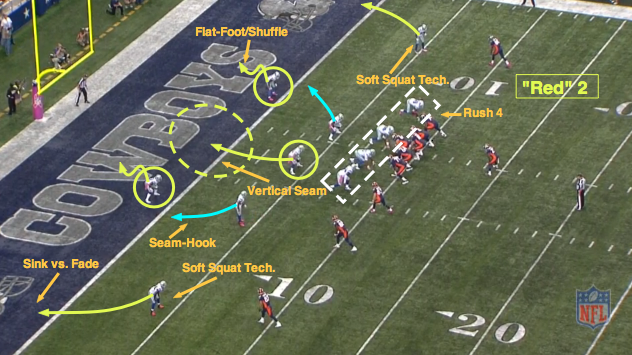










This is great stuff..what situations..down/ distance etc..is it best called?
ReplyDeleteFor the most part they can be used regardless of down/distance with the exception of Red 2 (redzone defense) and Green 2 (and long situations). Tampa 2 and Cover 2 were used as base defenses for years, and trap works as a sort of Cover 4/2 hybrid in many ways, so can be used regularly.
DeleteOne thing to always be weary of with Cover 2 though is that it's difficult to handle verts. The more moving parts you add, the more difficult it is to get guys to sink into coverage and cover those verts. So coverages like Invert 2 and Robber 2 you may want to use in "3rd and short/medium" type situations where you expect the offense to try to attack the sticks or possibly even run (you are getting better run defenders near the football, so it's good for that as well).